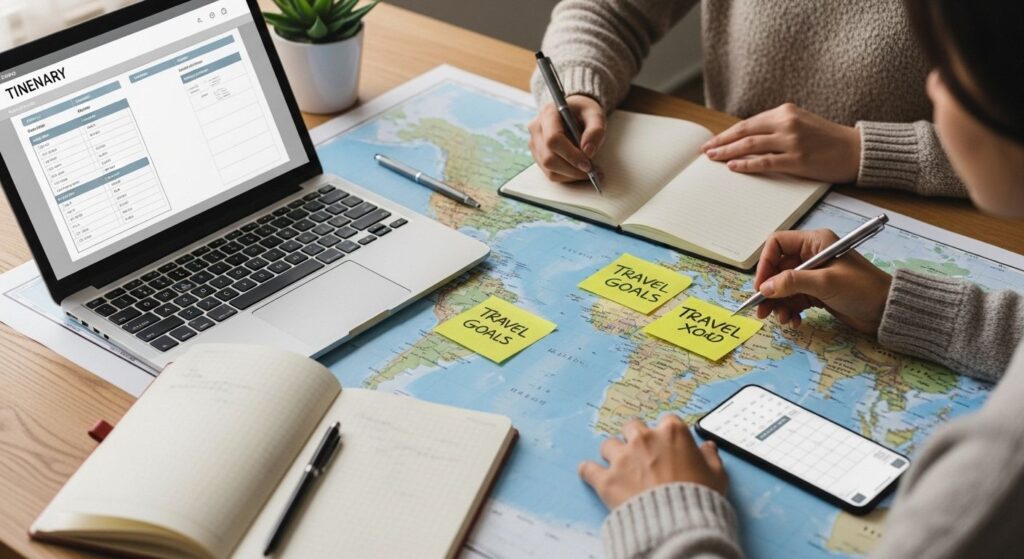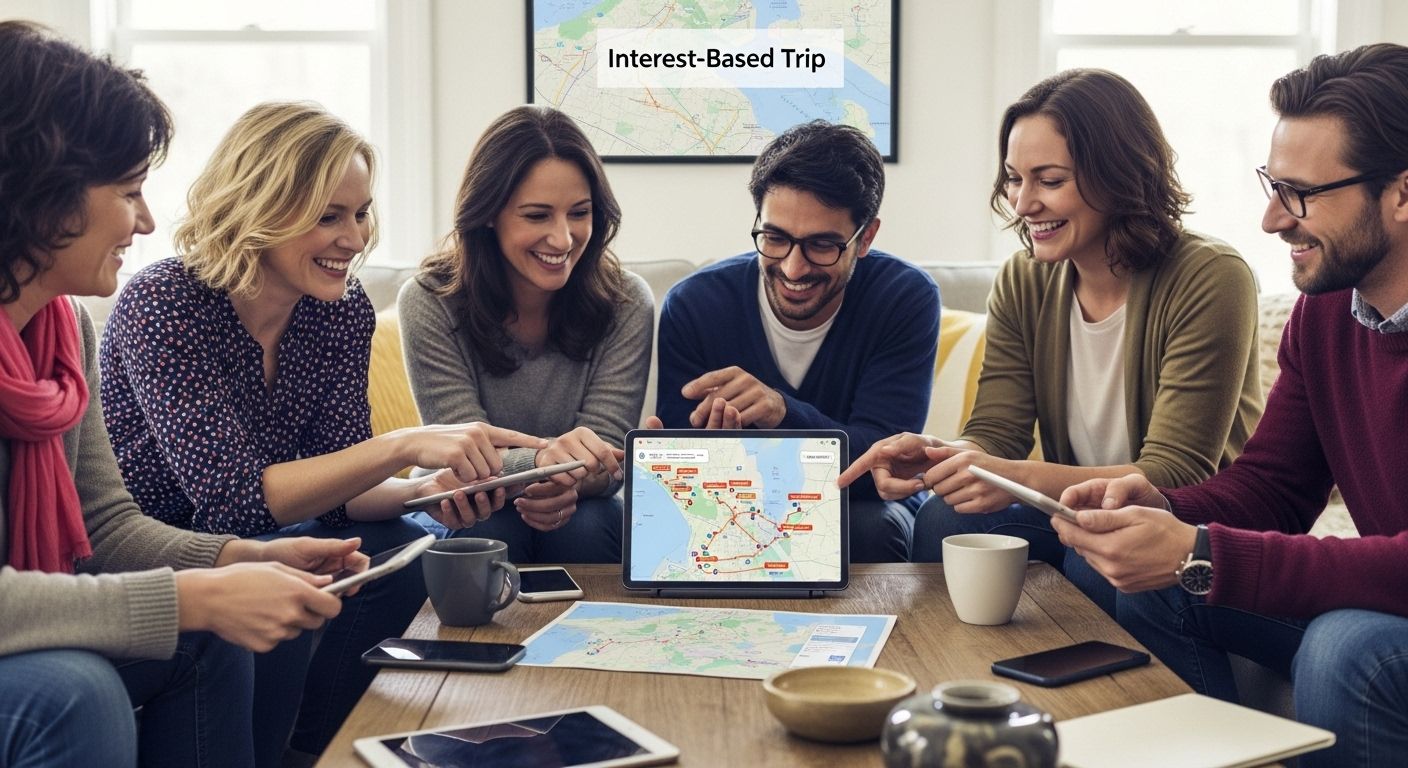Building the perfect travel itinerary is more than just picking flights and hotels. Nearly 80 percent of travelers say a detailed plan leads to a better trip, yet most people still end up feeling rushed or missing out on experiences they care about. The secret is not in doing more but in planning smarter, so even the busiest vacation becomes just the right amount of adventure and relaxation.
Table of Contents
- Step 1: Define Your Travel Goals And Preferences
- Step 2: Research Destinations And Activities
- Step 3: Organize Dates And Schedule
- Step 4: Create A Day-By-Day Itinerary
- Step 5: Review And Adjust The Itinerary
Quick Summary
| Key Point | Explanation |
|---|---|
| 1. Clearly define travel goals | Identify your main purpose for the trip, such as relaxation or adventure, to guide all planning decisions. |
| 2. Conduct thorough destination research | Use diverse resources like blogs and forums to understand destinations and local experiences before making choices. |
| 3. Organize a flexible schedule | Create a timeline that includes buffer time for spontaneity and adjusts for rest, ensuring activities are comfortably spaced. |
| 4. Develop a detailed day-by-day itinerary | Create a structured itinerary that outlines activities, transportation, and allows for easy updates and adjustments. |
| 5. Review and refine the itinerary | Critically evaluate the plan after a short break to ensure it meets travel goals and resolves potential logistical issues. |
Step 1: Define Your Travel Goals and Preferences
Creating an effective travel itinerary begins with a critical first step: clearly defining your travel goals and preferences. This foundational phase sets the entire trajectory for your trip, transforming a generic vacation into a personalized adventure tailored precisely to your desires.
Start by asking yourself fundamental questions about what you want to achieve with this trip. Are you seeking relaxation, cultural immersion, adventure, professional networking, or personal growth? Your travel goals will dramatically influence every subsequent planning decision. A beach vacation requires different preparations compared to a historical tour or a business trip.
Consider your personal preferences comprehensively. This includes your comfort level with different travel styles, budget constraints, physical abilities, and interests. Some travelers prefer structured experiences with guided tours, while others desire maximum flexibility. Your ideal trip might involve luxury accommodations or budget-friendly backpacking, depending on your individual preferences.
The ultimate trip planning approach involves creating a detailed personal profile that captures your travel personality. Reflect on past trips you’ve enjoyed and identify common themes. Do you gravitate toward urban experiences or natural landscapes? Are you interested in culinary exploration, historical sites, outdoor activities, or a blend of experiences?
According to the U.S. Department of Commerce, successful travel planning involves spacing activities comfortably and avoiding overly crowded schedules. This means being realistic about your energy levels and desired pace. Not every moment needs to be scheduled, and building in flexible time allows for spontaneous discoveries and rest.
To verify you’ve successfully completed this step, check that you can articulate:
- A clear primary purpose for your trip
- Your preferred travel style and comfort zones
- Specific experiences or destinations that excite you
- Realistic expectations about budget and time constraints
By thoroughly defining your travel goals and preferences, you’re laying a solid foundation for a memorable and satisfying journey. The next step will transform these insights into a structured travel blueprint that brings your vision to life.
Here is a checklist to help ensure you have fully defined your travel goals and preferences before moving on to the next phase.
| Verification Item | What to Look For |
|---|---|
| Clear primary purpose | Can you state the main goal guiding your trip (e.g., relaxation, adventure)? |
| Preferred travel style & comfort zones | Have you identified your ideal travel pace, accommodation type, and group size? |
| Specific experiences or destinations | Are there particular activities or places that excite you? |
| Realistic expectations for budget & timing | Have you set a budget and acknowledged any time or resource limitations? |

Step 2: Research Destinations and Activities
After defining your travel goals and preferences, the next crucial step is diving deep into researching destinations and activities that align perfectly with your vision. This phase transforms your initial concept into a tangible travel blueprint, turning abstract desires into concrete possibilities.
Comprehensive destination research requires a strategic approach. Begin by leveraging multiple information sources including travel blogs, official tourism websites, travel forums, and social media platforms. Each platform offers unique insights that can help you understand the nuanced experiences a destination provides. Instagram and Pinterest can offer visual inspiration, while dedicated travel forums like TripAdvisor provide authentic traveler experiences and practical advice.
The following options table compares multiple resources and what they provide for destination and activity research, helping you choose the best sources for planning your trip.
| Resource Type | Unique Insights Provided | How to Use It |
|---|---|---|
| Travel Blogs | Personal experiences, hidden gems | Read for inspiration and insider tips |
| Official Tourism Websites | Up-to-date events, cultural highlights, safety alerts | Verify essential information and logistics |
| Travel Forums | Authentic reviews, practical advice | Ask questions, read traveler reviews |
| Social Media Platforms | Visual inspiration, trending local spots | Discover locations via images and stories |
| Government Travel Sites | Visa info, safety advisories, legal requirements | Check requirements and travel advisories |
Consider creating a digital research folder where you can collect and organize information about potential destinations. Utilize tools like Google Docs or Pinterest boards to compile screenshots, articles, and notes. Pay special attention to seasonal considerations, local events, cultural festivals, and weather patterns that might impact your travel experience. Some destinations offer dramatically different experiences depending on the time of year, so understanding these variations is critical.
Unlock your trip planning potential by developing a systematic research approach. Check official government travel websites for current safety information, visa requirements, and travel advisories. Compare multiple sources to get a well-rounded understanding of each potential destination. Look beyond tourist marketing materials and seek out honest, comprehensive information from multiple perspectives.
According to the Library of Congress research guide, effective travel research involves understanding not just the destination, but the cultural context and practical travel considerations. This means investigating transportation options, local customs, language basics, and potential cultural sensitivities that could impact your experience.
To verify you’ve successfully completed this research phase, ensure you can confidently answer these key questions:
- What unique experiences does each potential destination offer?
- How do local conditions align with your travel goals and preferences?
- What are the practical considerations for visiting (costs, safety, accessibility)?
- Do the destination’s characteristics match your initial travel vision?
By meticulously researching destinations and activities, you’re building a solid foundation for an extraordinary travel experience. The insights you gather now will directly inform your next step: creating a detailed, personalized itinerary that brings your travel dreams to life.
Step 3: Organize Dates and Schedule
With your research complete, the next critical phase is transforming your travel insights into a structured, realistic schedule. Organizing dates and creating a comprehensive travel timeline requires precision and flexibility, bridging the gap between your travel dreams and practical implementation.
Begin by selecting your primary travel dates, considering factors like work commitments, seasonal variations, and potential travel constraints. Digital calendar tools like Google Calendar or Apple Calendar can be incredibly helpful for mapping out your journey. These platforms allow you to color-code different types of activities, track potential conflicts, and share your itinerary with travel companions or family members.
Consider creating a master travel spreadsheet that breaks down your trip into detailed segments. Include columns for dates, specific locations, planned activities, transportation details, and reservation information. This approach provides a comprehensive overview while allowing room for spontaneous adjustments. Remember that a great itinerary balances structured planning with enough flexibility to embrace unexpected opportunities.
Discover expert trip planning strategies that help you create a dynamic travel schedule. When organizing your dates, factor in travel time between destinations, potential jet lag, and buffer periods for unexpected delays or rest. Most experienced travelers recommend allocating 20-30% of your total trip time as flexible exploration time, preventing an overly rigid schedule that can lead to travel fatigue.
According to the U.S. Department of Commerce, an effective travel schedule should include two or three confirmed activities per day, strategically spaced to allow comfortable transitions and prevent exhaustion. This means avoiding back-to-back intensive experiences and building in moments for rest, reflection, and spontaneous discovery.
To verify you’ve successfully organized your dates and schedule, confirm you have:
- A clear, chronological breakdown of your travel dates
- Specific activities mapped to each day of your trip
- Identified transportation and accommodation details
- Buffer time for unexpected events or rest periods
- Shared your preliminary itinerary with relevant travel companions
By meticulously organizing your dates and creating a thoughtful schedule, you’re setting the stage for a well-structured, enjoyable travel experience. The groundwork you’ve laid will make the next steps of booking and finalizing your trip significantly smoother and more intuitive.
Step 4: Create a Day-by-Day Itinerary
Transforming your travel research and schedule into a detailed day-by-day itinerary is where your trip truly comes to life. This step is the blueprint that transforms abstract plans into a concrete travel experience, connecting your initial goals with practical implementation.
Start by creating a comprehensive template that captures every essential detail for each day of your trip. Digital tools like Google Sheets or specialized travel planning apps can be incredibly helpful. Prioritize creating a dynamic document that allows for easy modifications and real-time updates. Your day-by-day plan should include specific times, locations, transportation details, reservation information, and potential backup options for each activity.
Approach your day-by-day planning with strategic flexibility. Group your activities geographically to minimize travel time and reduce unnecessary movement. Consider the energy levels required for different experiences and distribute high-intensity activities strategically throughout your trip. For instance, plan more demanding tours or hikes earlier in your journey when you’re fresh, and leave more relaxed activities for later days when travel fatigue might set in.
Master the art of trip planning by incorporating buffer time between activities. Experienced travelers recommend allowing 30-60 minutes of transition time between scheduled events. This cushion accommodates unexpected delays, provides opportunities for spontaneous exploration, and prevents the stress of racing from one location to another.
According to the U.S. Department of Commerce, an effective itinerary should include two or three confirmed activities per day, thoughtfully spaced to maximize enjoyment and minimize exhaustion. This approach ensures you’re experiencing your destination thoroughly without overwhelming yourself.
Consider creating a color-coded system in your itinerary to quickly visualize different types of activities:
- Blue for transportation and travel logistics
- Green for scheduled tours or guided experiences
- Yellow for dining reservations
- Orange for flexible exploration time
- Red for critical must-do activities
To verify you’ve successfully created a comprehensive day-by-day itinerary, ensure you have:
- Detailed plans for each day of your trip
- Geographical clustering of activities
- Buffer times between scheduled events
- Backup plans for potential disruptions
- Shared and synchronized version with travel companions
By crafting a meticulous yet flexible day-by-day itinerary, you’re setting the stage for a well-organized, enjoyable travel experience that balances structure with spontaneity.

Step 5: Review and Adjust the Itinerary
The final crucial step in crafting a stellar travel plan is a comprehensive review and strategic adjustment of your meticulously developed itinerary. This is where you transform a good travel plan into an exceptional, resilient journey that can adapt to real-world complexities and unexpected opportunities.
Begin your review process by creating distance from your initial planning. Wait a day or two after completing your draft itinerary, then return with fresh eyes. This temporal separation allows you to evaluate your plan more objectively, identifying potential logistical challenges or overly ambitious scheduling that might have seemed reasonable during initial planning. Scrutinize each day’s activities with a critical lens, asking yourself whether the proposed schedule is genuinely achievable and enjoyable.
Realistic assessment is the cornerstone of an excellent travel plan. Consider factors like travel time between locations, potential weather variations, local transportation reliability, and your personal energy levels. Look for potential bottlenecks or unrealistic time allocations that could create unnecessary stress during your trip. Some travelers find it helpful to simulate their itinerary by walking through each day mentally, noting any moments that seem rushed or impractical.
Unlock advanced trip planning techniques by sharing your draft itinerary with trusted travel companions or experienced travelers who can provide objective feedback. Their external perspective might reveal overlooked details or suggest improvements you hadn’t considered. Online travel forums and community groups can also be valuable resources for getting nuanced advice about specific destinations and travel strategies.
According to the U.S. Department of Commerce, an effective travel plan should include confirmed activities strategically spaced throughout your journey, with built-in flexibility for unexpected developments. This means creating a dynamic document that can be easily modified without completely dismantling your entire travel strategy.
Consider these critical areas during your review:
- Transportation connections and potential delays
- Alignment with original travel goals
- Balance between structured activities and free time
- Budget implications of proposed activities
- Personal comfort and energy management
To verify you’ve successfully reviewed and adjusted your itinerary, confirm you have:
- Critically evaluated each day’s proposed activities
- Identified and resolved potential logistical challenges
- Incorporated feedback from trusted sources
- Created buffer times for unexpected events
- Maintained alignment with your original travel objectives
By meticulously reviewing and adjusting your itinerary, you’re setting the stage for a smooth, enjoyable travel experience that balances careful planning with the excitement of spontaneous discovery.
Stop Wasting Time on Travel Planning – Let Yopki Handle It All
You have just read how creating a personalized, detailed travel itinerary involves a lot of hard work. From defining your travel goals to researching destinations and organizing your schedule, every step is time-consuming and often leaves you second-guessing your plans. Even with the best intentions, the process can be overwhelming, leading to stressful spreadsheets, missed details, and endless tabs open on your device. What if there was a faster, easier way to bring your travel vision to life, keep everything in one place, and ensure no step is missed?

Transform how you travel by using Yopki’s all-in-one trip planner. Instantly generate a trip plan that reflects your unique interests. Visualize each day with our smart map and drag-and-drop calendar. No more shuffling between documents or losing track of confirmations. Whether you want to save time, eliminate stress, or just enjoy building the perfect journey, start now on Yopki and experience truly effortless travel planning. Your next unforgettable trip is only a click away.
Frequently Asked Questions
What is the first step in creating a travel itinerary?
Start by defining your travel goals and preferences. Consider what you hope to achieve with the trip, such as relaxation, cultural experiences, or adventure, as well as your personal travel style and budget.
How can I effectively research destinations for my trip?
Utilize a variety of sources including travel blogs, official tourism websites, and social media. Create a digital folder to organize materials and pay special attention to seasonal variations and local events that might enhance your experience.
What should I include in my day-by-day itinerary?
Your day-by-day itinerary should include specific times, locations, transportation details, reservation information, and buffer times between activities. Ensure that activities are geographically clustered to minimize travel time.
How do I review and adjust my itinerary after creating it?
After completing your draft itinerary, take a break before reviewing it. Assess each day’s schedule critically for logistical challenges and feasibility. Share it with trusted friends or experienced travelers for feedback and adjust accordingly.



